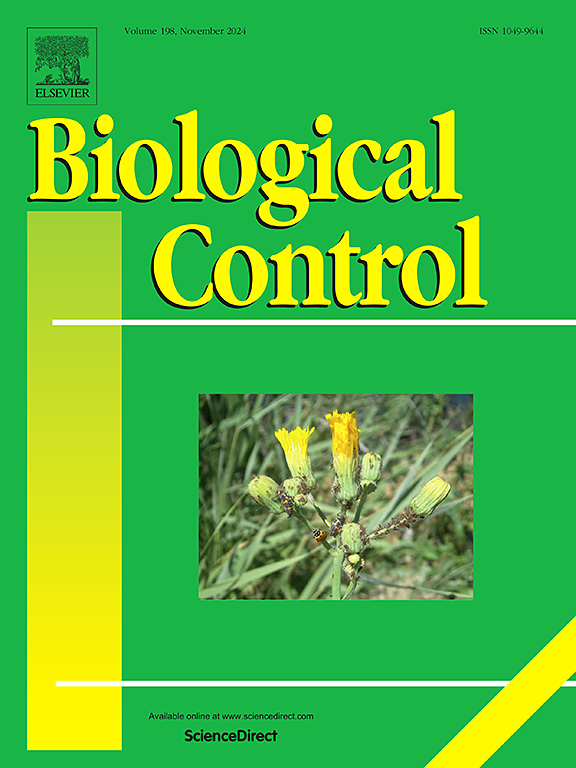Persistence of the entomopathogenic nematode Steinernema feltiae in a novel capsule formulation
IF 3.7
2区 农林科学
Q2 BIOTECHNOLOGY & APPLIED MICROBIOLOGY
引用次数: 0
Abstract
The post-application persistence of entomopathogenic nematodes (EPNs) depends on environmental conditions, which affect their efficacy as biocontrol agents in the field. This study evaluated the persistence of the EPN Steinernema feltiae in a novel hydrogel/emulsion capsule formulation under laboratory and field conditions. The new formulation was compared to the traditional aqueous application, using the baiting method with Tenebrio molitor larvae. In laboratory experiments, the capsule formulation of S. feltiae ENO2 strain was compared with aqueous applications of ENO2 and SN strain at 23 °C for 0, 7, 14, 21, and 28 days after treatment (DAT) in soil cups. The ENO2 capsule formulation persisted longer than ENO2 aqueous, while SN aqueous also persisted better than the ENO2 aqueous application but was not different from the ENO2 treatment. In field trials, the capsule formulation (applied sub-surface) persisted longer than the aqueous application (applied on the surface) of ENO2 when applied in recommended methods; however, there were no differences between formulations when applied in-furrow (sub-surface) or on the soil surface. Comparing the application methods, the sub-surface application improved the persistence of capsules over the surface application while it did not affect the performance of the aqueous application. Overall, these findings suggest the capsule formulation buried in the soil improves EPN persistence.
昆虫病原线虫 Steinernema feltiae 在新型胶囊制剂中的持久性
昆虫病原线虫(EPNs)施用后的持久性取决于环境条件,环境条件影响其作为田间生物防治剂的效果。本研究在实验室和现场条件下评估了EPN在一种新型水凝胶/乳液胶囊制剂中的持久性。以黄粉虫幼虫为饵,与传统的水驱法进行了比较。在室内实验中,比较了S. feltiae ENO2菌株的胶囊配方与ENO2和SN菌株在23℃条件下处理后0、7、14、21和28 d (DAT)在土壤杯中的水处理。ENO2胶囊的持续时间比ENO2水处理更长,SN水处理的持续时间也比ENO2水处理好,但与ENO2处理没有差异。在田间试验中,按推荐方法施用时,胶囊配方(亚表面施用)比ENO2水溶液(表面施用)持续时间更长;然而,当施用在沟内(地下)或土壤表面时,配方之间没有差异。对比两种应用方法,亚表面应用比表面应用提高了胶囊的持久性,而不影响水应用的性能。总的来说,这些发现表明,埋在土壤中的胶囊配方可以改善EPN的持久性。
本文章由计算机程序翻译,如有差异,请以英文原文为准。
求助全文
约1分钟内获得全文
求助全文
来源期刊

Biological Control
生物-昆虫学
CiteScore
7.40
自引率
7.10%
发文量
220
审稿时长
63 days
期刊介绍:
Biological control is an environmentally sound and effective means of reducing or mitigating pests and pest effects through the use of natural enemies. The aim of Biological Control is to promote this science and technology through publication of original research articles and reviews of research and theory. The journal devotes a section to reports on biotechnologies dealing with the elucidation and use of genes or gene products for the enhancement of biological control agents.
The journal encompasses biological control of viral, microbial, nematode, insect, mite, weed, and vertebrate pests in agriculture, aquatic, forest, natural resource, stored product, and urban environments. Biological control of arthropod pests of human and domestic animals is also included. Ecological, molecular, and biotechnological approaches to the understanding of biological control are welcome.
 求助内容:
求助内容: 应助结果提醒方式:
应助结果提醒方式:


